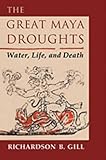The great Maya droughts: water, life and death / Richardson Benedict Gill
Por: Gill, Richardson Benedict [autor/a].
Tipo de material: Libro
impreso(a)
Editor: Albuquerque, New Mexico, USA: University of New Mexico Press, 2000Descripción: xx, 464 páginas : ilustraciones, mapas ; 23 centímetros.ISBN: 0826327745; 9780826327741.Tema(s): Mayas
Libro
impreso(a)
Editor: Albuquerque, New Mexico, USA: University of New Mexico Press, 2000Descripción: xx, 464 páginas : ilustraciones, mapas ; 23 centímetros.ISBN: 0826327745; 9780826327741.Tema(s): Mayas| Tipo de ítem | Biblioteca actual | Colección | Signatura | Estado | Fecha de vencimiento | Código de barras |
|---|---|---|---|---|---|---|
| Libros |
Biblioteca Chetumal
Texto en configuración de biblioteca Chetumal |
FROSUR | Y 972.65 G55 | Disponible | ECO030007351 |
Bibliografía: páginas 389-444
Acknowledgements.. 1. Climate and castastrophe.. 2. Energy and environmental.. 3. Self-organization.. 4. Famine and the individual.. 5. Las hambrunas y la disolución social.. 6. Meteorology.. 7. Thermohaline circulation.. 8. Volcanoes and climate.. 9. Geology, hidrology, and water.. 10. Paleoclimatology.. 11. Drouth and famine.. 12. Abandonment and collapse.. 13. Summary and discussion.. 14. Bibliography.. Index
El misterio del colapso maya ha resultado ser un poderoso imán que ha atraído a muchas mentes inquisitivas y curiosas durante los últimos 150 años. Casi toda las explicaciones son intensos sinceros y minuciosos de echar alguna luz sobre la oscuridad que rodea las causas de la catástrofe que terminó con esa gran civilización. Con todo, muchas de las teorías propuestas adolecen de una falla grave: no logran explicar la desaparición de millones de personas. La arqueología no es una ciencia experimental que someta a prueba sus hipótesis en condiciones de laboratorio: hay que darle sentido al registro arqueológico imperfecto que consiste principalmente en huecos y lagunas con escasos fragmentos de indicios, ninguna de las cuales puede considerarse definitiva, y buscar su convergencia en una posible solución al rompecabezas. Este libro plantea argumentos que llevan a la conclusión de que los mayas murieron de hambre y sed, como resultado de una serie de devastadotas sequías ocurridas durante el siglo IX y X, y muestras paso a paso cómo ocurre una sequía y cómo puede desintegrarse una civilización cuando es atacada por ésta. Así el colapso ocurrió como resultado de circunstancias naturales externas que los mayas no pudieron controlar ni provocar. Fueron las víctimas, no los perpetradores. La historia de hambre que narra las páginas de este libro describe con crudeza el fin de una civilización; no obstante, permite profundizar en la comprensión de la manera como a lo largo de la historia se han relacionado los seres humanos con su mundo físico. spa
The mystery of the Maya collapse has proven to be strong magnet which has attracted many inquiring and creative minds over the last one hundred fifty years, as it has you and me. In previous work, I catalogued over eighty-eight proposed theories, explanations, or hypothese, as of 1999, my list exceeded one hundred. Almost all of the explanations I have gathered are thoughtful, sincere attempts to shine light on the darkness of the Maya Collapse. Many of the expositions, however, suffer from a major flaw. They state a proposition and jump straight to a conclusion without explaining the intervening steps that lead from one to the other. They fail to explain the mechaning of how their theory leads to the disappearance of millions of people. Archaeology is not an experimental science in which we can test our hypotheses in laboratory environments. We are left to make sense of an imperfect archaeological record which mainly of holes and gaps wich sparse fragment of between. The best we can do is to marshall many weak line of evidence which converge on solution to our puzzle because none by itself can be considered proof positive. You have already read what happened to the Maya. In the pages that follow I will mobilize a number of arguments which will lead us to the conclusion that the Maya died of famine and thirst, and I will show, step by step, how a civilization can disintegrate when it is assaulted by drougth and how a drought can occur in the Maya lowlands. The story of famine and death is not pretty, but we will learn a lot along the way about how human beings relate to the physical world in which we live. eng
